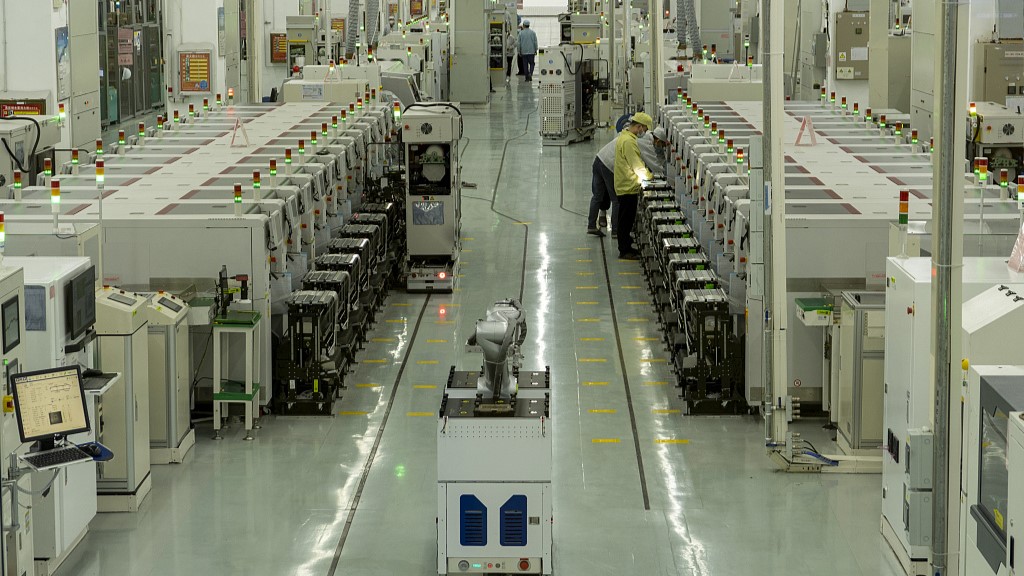
World Bank expects the generative AI market to grow to $6.5 billion by 2026. /CFP
World Bank expects the generative AI market to grow to $6.5 billion by 2026. /CFP
Generative artificial intelligence (AI) is revolutionizing smart manufacturing and is predicted to have a transformative impact, comparable to the introduction of smartphones.
This cutting-edge technology, powered by large language models (LLMs), goes beyond aiding poetry and essay writing, with the potential to generate plans and issue commands for systems to execute.
Industry experts foresee the potential of generative AI to reshape the manufacturing sector and accelerate the pace of intelligent factory upgrades.
China is especially well-positioned for rapid AI deployment due to its vast data reserves, expansive AI application scenarios, and strong demand.
Intelligent upgrades are no longer a choice but a necessity in the manufacturing industry, Shi Zhe, chief digital officer at Foxconn Technology Group, told CGTN.
Foxconn, the multinational electronics contract manufacturer, is undergoing a digital and intelligent transformation in a quest to maintain a sustainable competitive advantage over the next decade.
Currently, Foxconn is primarily focusing on the integration of AI and big data into operational management and production lines, said Shi.
This move comes with challenges, particularly the costs associated with application. Embedding AI models into factory plants is a complex process, as factories often adopt different stages of industrialization.
The first step towards intelligent manufacturing involves digitalization and data collection. Accumulating data is essential for feeding the AI system and enabling intelligent applications.
Artificial general intelligence (AGI) has made investing in intelligent upgrades more cost-effective as the company hopes for significant improvements in production efficiency and optimized resource allocation, Shi added.

A Foxconn production plant in central China's Henan Province, January 21, 2023. /CFP
A Foxconn production plant in central China's Henan Province, January 21, 2023. /CFP
Production lines require collaboration among various departments, such as engineers, mechanics, IT personnel, production managers, and material managers.
The ideal is to utilize AI in analyzing available data and application scenarios, in order to identify more efficient methods of completing tasks.
The manufacturing industry requires accurate task handling models, emphasizing the importance of finding a model with absolute correctness instead of continuously optimizing existing models.
In practice, occasional "hallucinations" or made-up information generated by AI models pose headaches, particularly for maintaining product yield rates.
While algorithms and systems can make sound decisions in the manufacturing industry, human judgment, experience, and creativity remain crucial, especially when dealing with complex or non-standardized situations like production design and asset operation.
In many industries, cost and efficiency considerations often prioritize manual tasks despite advancements in technology. Foxconn still heavily relies on mechanization for production, with manual operations still involved in iPhone assembly.
Complex tasks, however, often require the assistance of precision equipment, as in the case of almost entirely automated semiconductor assembly lines.
Intelligent manufacturing is becoming a prevailing trend and development direction for the entire industry, Huang Tiejun, professor of the School of Electronic Engineering and Computer Science at Peking University, told CGTN.
Enterprises that efficiently utilize AI systems and continuously upgrade their capabilities will gain a competitive advantage, while those refusing to adapt may risk elimination, Huang added.
To attain a lead in generative AI technology globally, it is crucial to strengthen resource integration, seek cooperation, respect innovation, and integrate resources, he stressed.
According to the World Bank, the generative AI market is projected to grow from $1.5 billion in 2021 to $6.5 billion by 2026, with a compound annual growth rate of 34.9 percent.
Gartner, a technology consulting firm, predicts that generative AI will generate 10 percent of all data by 2025, a surge from the current share of less than 1 percent.
Given the ever-evolving application scenarios, the development of AGI appears inevitable, leaving us all wondering what the future holds.